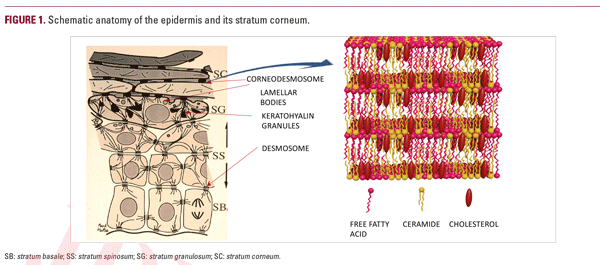
The relative impermeability of the SC and, thus, its barrier function, rely essentially on the intercellular lipids, even though they account for only 15% of the SC weight. Quasi equimolar proportions of ceramides, cholesterol, and free fatty acids appear to be prerequisite for the correct auto-assembly of the intercellular lipid multilayers within the SC. The composition of the lipids of the SC further subdivides into free fatty acids (FFA; 10%), cholesterol (CHOL; 27%), cholesterol esters (10%), cholesterol sulfate (3%), and ceramides (CER; 50%).13 These lipids organized in multiple bi-layers parallel to the corneocyte surfaces may assemble within the layers into domains presenting different densities. A dense orthorhombic lateral packing of lipid molecules and a more fluid hexagonal format predominate in normal human skin.14 Efficient filling of SC interstices is essential for preventing excessive water loss and penetration of environmental contaminants/aggressors.
Ceramides are structurally heterogeneous sphingolipids that can be classified by their molecular structures and their polarity into 12 classes of unbound ceramides and 3 classes of covalently bound ceramides.15 Names of these families of molecular structures reflect the differences in their (i) sphingoid bases (S: Sphingosine, DS: Sphinganine, and P: Phytosphingosine) and (ii) acyl chains (N: Non-hydroxy FA, A: α-hydroxyl FA, EO: esterification of ω-hydroxyl FA with linoleic acid, and O: ω-hydroxyl-FA). Within the different classes of ceramides, CER [NP] (22%), CER [NH] (14.5%), CER -[H] (10.8%), AS (9.6%), CER [NDS] (9.8%), CER [AP] (8.8%), and CER [NS] (7.4%) compose the majority of the free and bound ceramides.16,17 Free FA chain length is most commonly 18, 22, or 24 carbon atoms. The differences in chain length and the different subclasses of ceramides are regulated by different biosynthesis pathways (de novo, sphingomyelinase, and salvage via late endosomes) and are subjected to change in various skin disease conditions.18
In particular, the dynamic changes to ceramides CER[EOS], CER[NP], and CER[NP] in atopic dermatitis and psoriasis patients are clues for the design of different product options to alleviate the symptoms at the lesional skin sites.13 In addition to their crucial structural functions within the SC, ceramides are also able to influence keratinocyte differentiation and apoptosis. Glycosylated, short, and long chain ceramides, all have been demonstrated to enhance differentiation of keratinocytes. This suggests an additional explanation of how ceramides improve the barrier function: through influencing the proliferation/ differentiation balance within the living epidermal layers, resulting in enhanced formation of SC.
New Players in the Epidermal Barrier Function
Since the middle of the past century, the views on the place of the horny layer in epidermal biology have changed dramatically. SC has ceased to be considered not more than a kind of Saran® wrap and acquired the status of a complex and highly interactive biosensor.19 The fundamental role of the intercellular lipids for the SC relative impermeability has been put forward and elaborated upon by various groups.20 Peter Elias’ ‘brick and mortar’ concept of the barrier has been widely accepted and studied in detail using various physical-chemicalstructural and experimental approaches, each contributing to a better understanding of the barrier function.21–25 As more studies have emerged, it has become clear that the establishment and maintenance of a healthy skin barrier relies on coordinated processes from keratinocyte proliferation to desquamation that must constantly adapt to the environmental conditions (for indepth reviews, please consult "Skin barrier", Elias & Feingold, Eds., 2005).26
The initially ignored epidermal tight junctions (TJ) and their structural remnants that persist in the SC were shown






